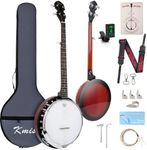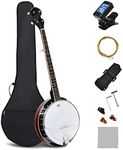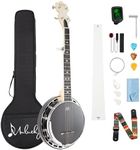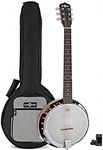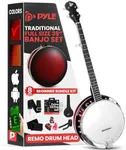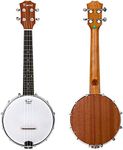Buying Guide for the Best Banjos
Choosing the right banjo can be a rewarding experience, whether you're a beginner or an experienced player. The banjo is a versatile instrument with a unique sound, and selecting the right one involves understanding various specifications that affect its playability and tone. Consider what style of music you want to play, your skill level, and personal preferences in sound and feel. By focusing on key specifications, you can find a banjo that suits your needs and enhances your musical journey.Type of BanjoBanjos come in different types, primarily 4-string, 5-string, and 6-string, each suited for different styles of music. The 5-string banjo is the most common and is often used in bluegrass and folk music. The 4-string banjo, also known as a tenor or plectrum banjo, is popular in jazz and Irish music. The 6-string banjo, sometimes called a banjitar, is tuned like a guitar and is great for guitar players transitioning to banjo. Choose the type based on the genre you are interested in and your current playing skills.
Resonator vs. Open BackBanjos can have either a resonator or an open back, which affects the sound projection and tone. A resonator banjo has a backplate that projects the sound forward, making it louder and more suitable for bluegrass and ensemble playing. An open-back banjo has a softer, mellower sound, often preferred for clawhammer and old-time music. Consider where and how you plan to play; if you need more volume and projection, a resonator might be better, while an open back is ideal for solo or softer music.
Neck MaterialThe neck material of a banjo affects its durability, weight, and tone. Common materials include maple, mahogany, and walnut. Maple necks are known for their bright tone and are often used in bluegrass banjos. Mahogany provides a warmer, softer sound, while walnut offers a balance between the two. Consider the tonal qualities you prefer and the weight you are comfortable with, as different woods can also affect the overall weight of the instrument.
Rim and Tone RingThe rim and tone ring are crucial components that influence the banjo's sound. The rim is the circular part of the body, and the tone ring is a metal ring that sits on top of the rim. A banjo with a tone ring generally has a brighter, more powerful sound, which is desirable for bluegrass. Banjos without a tone ring tend to have a softer, more mellow tone. Decide based on the sound you are aiming for; if you want a punchy, loud sound, look for a banjo with a tone ring.
Scale LengthThe scale length of a banjo is the distance from the nut to the bridge and affects the tension and playability of the strings. A longer scale length can provide more tension and a brighter sound, while a shorter scale length offers less tension and a warmer tone. Beginners might find a shorter scale length easier to play, while more experienced players might prefer the sound and feel of a longer scale. Consider your comfort and the sound you want when choosing the scale length.
String MaterialBanjo strings can be made from various materials, including steel, nickel, and phosphor bronze, each affecting the tone and feel. Steel strings are bright and loud, making them popular for bluegrass. Nickel strings offer a balanced tone and are versatile for different styles. Phosphor bronze strings provide a warmer, richer sound, often used in folk and old-time music. Choose string material based on the sound you prefer and the style of music you intend to play.


